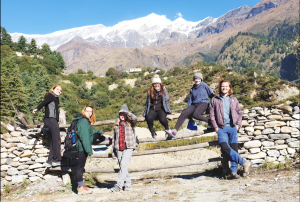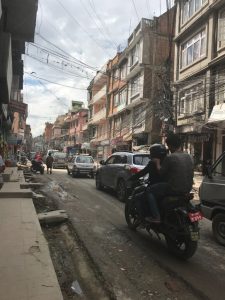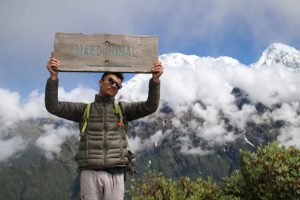Written by Jake Gunther ’22

Photo by Allyson Krupa ’21
With over 300 program options to choose from, making the decision of where you’ll study abroad is not an easy one. And it’s for good reason: each program offers something unique–different, languages, and cultures, and places around the globe. And while the websites- full of course catalogs, excursion details, and program summaries – give you a taste of what your semester will be like, it’s hard to decide which location/program is right for you just from words and pictures on a screen. A great way, however, is to take it from people who know the country firsthand. Allyson Krupa ‘21, an Environmental Studies major studied in Nepal last year on a fantastic, albeit lesser-known program: SIT Nepal: Development, Gender, and Social Change in the Himalaya. Pede Regmi ‘24 has lived in Kathmandu, the capital of Nepal, his whole life. Having gone to Nepal just a year ago, Allyson knows the ins and outs of the program. And having grown up in Kathmandu, Pede is an expert on his hometown.
I spoke with Allyson to learn more about her experience in the South Asian country. Allyson recalls how she landed on SIT Nepal in the first place. Her top priority was to have a truly immersive experience. And this program checks off all the boxes for a deeply engaging semester: multiple homestays, constant interactions with locals, and the necessity to speak a language other than English. Allyson describes living at a homestay as a familial experience. With such an inviting culture, she felt right at home with two new loving parents, a younger brother, and two little sisters. She shared daily meals with her family, played card games with her sisters, and helped her brother with his English homework.
At SIT Nepal during the last four weeks of your semester, you can choose to get an internship or pursue independent research. Allyson chose the latter and did research on electric vehicle development in Kathmandu. Unlike many university-based programs where you attend classes at a local school, SIT programs have their own teaching centers where a small cohort of students learn together. As Allyson puts it, “It’s kind of like a little family.” There you take the core courses and intensive language classes which help prepare you for your independent research project or internship.

Allyson and fellow SIT classmates taking a break from hiking and class for a photo during their rural excursion. (Photo by Allyson Krupa ’21)
Being an environmental studies major, Allyson wanted an experience where she could interact with nature, but she also wanted a holistic program. She found that with SIT Nepal, learning about the country’s social development and discourse surrounding gender, migration, and rural growth among other topics. Allyson admits that the focused academics are different than a semester on the hill, but she enjoys the rigor. She says, “Doing an SIT program is definitely more rewarding, in the sense that it’s definitely more challenging because they give you a lot of freedom and force you to interact with locals.”

Allyson with her little sister (far right) and two kids from the village during the rural homestay in the Himalayas of northern Nepal. (Photo by Allyson Krupa ’21)
Going abroad, especially to an SIT program, truly gives you the chance to step out of your comfort zone and embrace a new world. Allyson found this in Nepal as she reflected on her valuable trip, “I think being in any different culture you really discover more about how you navigate the world, and how you can engage with others who are obviously different than you.” For Allyson, this experience was eye-opening. She assimilated into a new culture, made local friends with whom she still keeps in touch, hiked the mountains, and explored a lively city. Having spent all this time adjusting to a new culture and developing a routine, Allyson says she feels confident to live anywhere.

A typical street view of Kathmandu: motorbikes, taxis, cars, and pedestrians along the road without strict traffic order. (Photo by Allyson Krupa ’21)
I later spoke with Pede who spent the first 18 years of his life in Nepal before relocating to Granville to attend Denison. In fact, because of COVID restrictions last fall, this is his first semester in person, and his first time in America. It’s taking him some time to get adjusted to the unpredictable Ohio weather. He tells me it’s nothing like Nepal, where the temperatures are more consistent and warmer. Spending time outdoors in the heat is actually one of Pede’s favorite past times. He notes, “I think for American people who want to study abroad in Nepal, they should definitely enjoy hiking.” With all the freedom SIT gives you, escaping the city for a little getaway is easy. In some instances, excursions will be through the program but other times you’ll be able to explore on your own or with friends. In Nepal, there are tons of outdoor opportunities. You can hike the Himalayas, the mountain range that includes Mount Everest. You can travel to a different Nepali city which will expose you to cultures different from Katmandu. In fact, in Nepal, there are 123 languages spoken and Pede says, “If you drive for a couple of hours you can see a completely different world, a completely new culture.” One great destination he recommends is Pokhara, a lakeside paradise where you can swim, boat, relax, and explore markets and geographic landmarks.

Pede posing for the camera near the base camp of the Mardi Himal. (Photo provided by Pede Regmi ’24)
A huge aspect of studying away from the U.S. is you get the chance to broaden your horizons. As someone who’s lived in Nepal for so long, Pede recognizes that it’s different from the Western living style many Denisonians are used to. Thus, he says you shouldn’t expect your abroad life to mirror what it is now, and going into this semester with an open mind will suit you best. This means, venturing into the night and trying new foods like mo-mos, an Asian steamed dumpling, or Pede’s favorite, Nepali style BBQ chicken that’s cooked over a fire. It means looking for an authentic Nepali experience by avoiding the monetized tourist traps and exploring local villages instead. And it means engaging passionately with your courses by immersing yourself in the local culture, routine, and rhythm of the city. If you can manage that, like Allyson was able to, then there’s no doubt SIT Nepal will be right up your alley.
There is a lot to factor in when deciding your study abroad destination, and it’s not unusual to be conflicted. But hearing from students who have lived two versions of the local experience helps make the choice just a tad easier.
